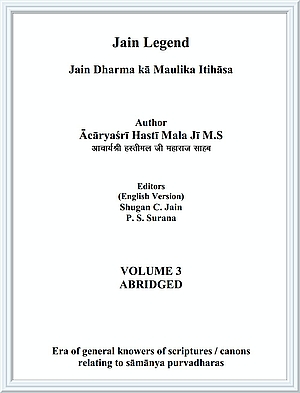Jain religion is a great and scientific religion and philosophy of the world. It is a religion of the believers in the attainment of the supreme and great development of through the purity of the practitioner and his/her objective. In this religion equal emphasis has been laid on the purity of both act and thought. Historically Jain religion is the oldest religion of the world. This religion is an independent religion. It is neither a branch of Hinduism nor of Buddhism. From archaeological, scientific, historical, linguistic, literature and leadership views, it has been established that a prosperous religious tradition existed before the onslaught of Vedic tradition in India. This religious tradition was called by different names from time to time. From this prosperous and ancient tradition, Lord Ādi Nātha was the first profounder in the present avasarpiṇī time era. In the Vedic holy texts also, the religion which had discussed, has its 24th Tīrthaṃkara as Lord Mahāvīra.
After Lord Mahāvīra, a tradition of luminary ācāryas started. From historical point of view, after Lord Mahāvīra, laxity in the conduct of the Śramaņa monks propounded by Lord Mahāvīra crept in during the twelve years long famines. Along with laxity in conduct even laxity in the thoughts also crept in leading to the bifurcation of the unified congregation as Digambara and Śvetāmbara. Later on several branches (gacchas) and sub gachhas started emerging from these sects as well. Fortunately from time to time, some distinguished personalities kept on emerging who kept the true form of conduct and doctrine in the congregation alive. Such personalities and their exemplary conduct became the source of great strength for the good followers who were few and far between. Reverend Ācārya Hastī Mala jī M.S. had been an unbiased thinker, nonpartisan discussant and highly sensitive person of the ācārya tradition. The deep belief in the conduct as per the Scriptures had been deeply rooted even in the smallest part of his life and conduct and projected in his writing of history of Jainism. History of Jainism had been written under his able guidance with lot of farsightedness. His fine intellect and farsightedness is visible in each and every chapter of this history books.
The author had to do more strenuous work in writing this present volume as compared to the earlier two volumes. This part of history is one which had been almost forgotten and hence became unavailable. There are so many contradictions which are beyond the capabilities of an ordinary writer to resolve. However, the author under the auspicious and distinguished guidance of Ācāryaśrī has put forth such facts in a manner that the reader feels happy and engrossed. The author has taken great pains to ensure that the pride and honour of Śramaņa tradition is deeply rooted in the conduct it propagates for its followers. Whenever laxity in the conduct crept in, the downfall of that tradition started. Downfall of Jain religion is primarily due to laxity of the conduct of its followers and rise of the same is related to the adherence by its followers to right conduct. His pen had moved very fast in refuting the pervert conduct but it is also a fact that he tried in his writing to put forth the truth and not to hurt anyone or his writings/ views. Similarly he never tried to refute or oppose any tradition or sect. His primary objective had been to bring forth the laxity in the thoughts and conduct of different sects and sub sects of Jains as and when they started to creep in the respective congregation / gacchha. The author has come out 100% successful in this mission. This is the only important thing.
Devendra Muni Śāstrī
Madanaganja-Kiśanaganja 28.10.08
 Acharya Hasti Mala
Acharya Hasti Mala
